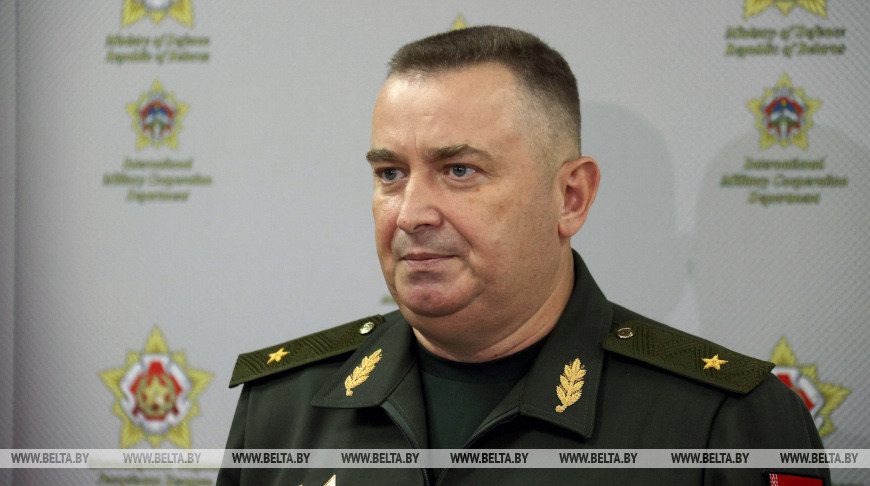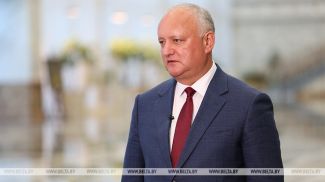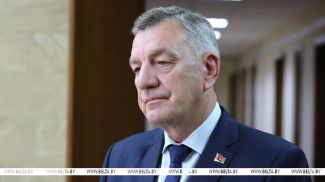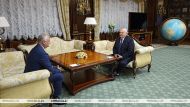
Valery Revenko
MINSK, 5 April (BelTA) – Valery Revenko, Chief of the International Military Cooperation Department, Aide for International Military Cooperation to the Belarusian Defense Minister, talked to reporters and explained in detail why Belarus has decided to suspend the Conventional Armed Forces in Europe Treaty and what consequences this decision may bring about, BelTA has learned.
Valery Revenko believes that the matter of suspending the Conventional Armed Forces in Europe Treaty is of current interest for Belarus and the decision had been in the making for a long time. He explained that the treaty determines certain quotas for every state with regard to the number of personnel, weapons, and military hardware in addition to stipulating measures to verify compliance with the treaty, including annual notification of CFE Treaty participating countries, mutual inspections of bases, arsenals, warehouses, and army units.
Limits set by the CFE Treaty and the real state of affairs in the Belarusian army
The Conventional Armed Forces in Europe Treaty limits the strength of the Belarusian army to at most 100,000 people, 1,800 tanks, 2,600 armored fighting vehicles, 1,615 units of artillery, 294 combat aircraft, and 80 combat helicopters.
The defense minister aide explained that after suspending the CFE Treaty Belarus will no longer have to observe these quotas and will be able to abandon compliance verification measures both with regard to foreign countries and with regard to Belarus.
However, if the parliament passes the bill, the actual suspension of the Conventional Armed Forces in Europe Treaty will not change the real state of affairs much. For instance, the part concerning quotas and limits. For a long time the Belarusian army’s strength has been at 65,000 people, which is way less than the 100,000 people the treaty stipulates. “As for weapons and military equipment, we don’t expect some massive increase in the inventory or changes in the near future,” Valery Revenko said.
“As for inspection activities. Regretfully, in the current situation Western countries ignore matters concerning the fulfillment of the Conventional Armed Forces in Europe Treaty. In other words, they refuse to inspect our state. In turn, we cannot inspect foreign states because they have created a situation where they don’t welcome our inspections,” he added.
Background
In 1990 when the Conventional Armed Forces in Europe Treaty was signed, introducing these limits and restrictions seemed like a good idea because country blocs like NATO and the Warsaw Pact Organization existed. The treaty came into force in 1992. But by that time the situation had changed significantly due to the collapse of the Soviet Union, the breaking up of the Warsaw Pact Organization, the division of Czechoslovakia, and the reunification of Germany. This is why an agreement was signed in Tashkent, Uzbekistan in 1992 to split the USSR quota among the new independent states. “In other words, each state received its own quota, its own figure that limited the army strength, the number of weapons and military hardware,” Valery Revenko noted.
However, by the late 1990s a number of former Warsaw Pack Organization member states had joined NATO and the existing limits of military hardware specified for the country blocs were no longer meaningful. It was time to move from bloc-based restrictions to national and territorial ones.
“The balance was disrupted. In order to restore it, it was necessary to adapt the treaty to the existing reality. In 1999 [at an OSCE summit in Istanbul] 30 countries signed this treaty [the Adapted Conventional Armed Forces in Europe Treaty]. But regretfully only four countries ratified it: Belarus, Russia, Kazakhstan, and Ukraine [although all the parties to the original treaty were supposed to ratify the adapted one],” the defense minister aide said.
Emergence of “grey zones”
“The failure to sign the adapted treaty became the starting point and signified the impending demise of this treaty. Personnel numbers and hardware numbers were not verified. Unfortunately, ‘grey zones’ emerged. The countries that were outside the CFE Treaty (Estonia, Latvia, and Lithuania) could freely increase the number of weapons and the number of personnel, including from foreign countries. We see it today: battalion tactical groups are converted into brigade groups, not only individual NATO groups join the troops but also the USA. In other words, the balance is violated,” Valery Revenko pointed out.
In his words, it poses a threat to Belarus’ national security, destabilizes the situation in the Eastern Europe region, and violates the European security architecture. “Unfortunately, it is happening today,” he stated. “The year 1999 was the starting point for destroying this treaty. Later on countries started interpreting the treaty provisions any way they wanted. Some countries stopped honoring this treaty.”
The current state of affairs
For instance, in 2020 during the coronavirus pandemic Western countries stopped honoring their obligations as part of the CFE Treaty and continued doing it even for two years after the pandemic ended. “For them it was a very good pretext for increasing their forces and assets, personnel numbers, including foreign personnel,” the defense minister aide believes.
Practically all the countries of the NATO bloc have ignored the fulfillment of the Conventional Armed Forces in Europe Treaty since that time, including the part that requires providing information about the number of weapons. No inspections took place in Belarus according to the CFE Treaty. Belarusian specialists did not take part in inspections in other countries either. “In other words, conditions conducive to the lack of control over the buildup of the stock of weapons and military hardware have emerged,” Valery Revenko said.
In November 2023 NATO’s North Atlantic Council declared the intention of the NATO member states, which are parties to the treaty, to suspend the treaty’s effect. The Russian Federation has also withdrawn from the Conventional Armed Forces in Europe Treaty.
Belarus’ response
“What should Belarus do in these conditions? We have to respond. Does it make sense to provide information [about Belarus’ Armed Forces according to the CFE Treaty] to Western countries if Belarus lacks such information from them? Certainly, it makes no sense anymore. We have to do something,” the official explained.
Valery Revenko stressed that Belarus will only suspend its participation in the Conventional Armed Forces in Europe Treaty and will not withdraw from the treaty: “We can always withdraw. But rebuilding the treaty anew is an exceedingly arduous task. Particularly in current conditions.”













